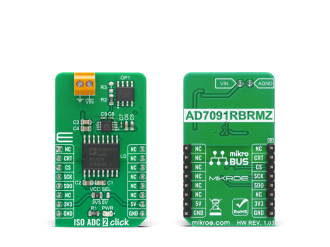
We strongly encourage users to use Package manager for sharing their code on Libstock website, because it boosts your efficiency and leaves the end user with no room for error. [more info]

Rating:
Author: MIKROE
Last Updated: 2020-08-14
Package Version: 1.0.0.0
mikroSDK Library: 1.0.0.0
Category: ADC
Downloaded: 3217 times
Not followed.
License: MIT license
ISO ADC 2 Click is a compact add-on board that represents a completely isolated 12-bit, 300 kSPS data acquisition system. This board features the AD7091R, successive-approximation analog-to-digital converter (ADC) from Analog Devices.
Do you want to subscribe in order to receive notifications regarding "ISO ADC 2 click" changes.
Do you want to unsubscribe in order to stop receiving notifications regarding "ISO ADC 2 click" changes.
Do you want to report abuse regarding "ISO ADC 2 click".


Library Description
Key functions:
uint16_t isoadc2_read_adc ( void ) - Function for reading 12bit ADC datauint16_t isoadc2_get_mv ( uint16_t adc_data ) - Function for converting ADC to mV dataExamples description
The application is composed of three sections :
void application_task ( )
{
char demo_txt[ 30 ];
uint16_t rx_data;
uint16_t mv_data;
rx_data = isoadc2_read_adc( );
mv_data = isoadc2_get_mv( rx_data );
WordToStr( rx_data, demo_txt );
mikrobus_logWrite( " - ADC: ", _LOG_TEXT );
mikrobus_logWrite( demo_txt, _LOG_LINE );
WordToStr( mv_data, demo_txt );
mikrobus_logWrite( " - VIN: ", _LOG_TEXT );
mikrobus_logWrite( demo_txt, _LOG_TEXT );
mikrobus_logWrite( " mV", _LOG_LINE );
mikrobus_logWrite( "---------------", _LOG_LINE );
Delay_ms( 1000 );
}
Other mikroE Libraries used in the example:
Additional notes and informations
Depending on the development board you are using, you may need USB UART click, USB UART 2 click or RS232 click to connect to your PC, for development systems with no UART to USB interface available on the board. The terminal available in all MikroElektronika compilers, or any other terminal application of your choice, can be used to read the message.